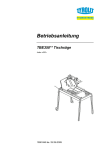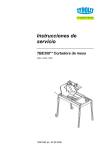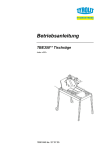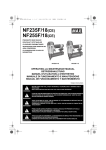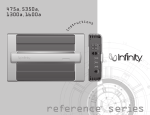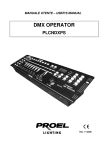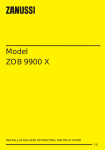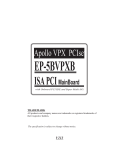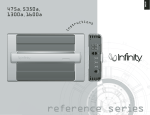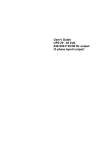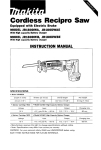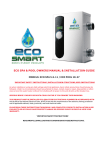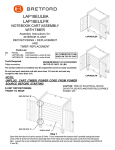Download Operating Instructions
Transcript
Operating Instructions TBE350** Table Saw Index / Indice «000» 10981449 en / 06.06.2009 Manufacturer's address: TYROLIT Hydrostress AG Witzbergstrasse 18 CH-8330 Pfäffikon Switzerland Tel. +41 (0)44 952 18 18 Fax +41 (0)44 952 18 00 www.hydrostress.com TYROLIT Hydrostress AG reserves the right to make technical changes without prior notice. Copyright © 2003 TYROLIT Hydrostress AG, CH-8330 Pfäffikon ZH, Switzerland All rights reserved, in particular copyrighting and translating rights. Printing of this operating manual, including extracts from it, is prohibited. No parts of it may be reproduced in any form or processed using electronic systems, duplicated or disseminated without the written permission of TYROLIT Hydrostress AG. 2 TBE350** Owner manual text TABLE OF CONTENTS Contents……………………………........... 3 Safety precautions……………………….. 4 General safety rules……………………. 5 Health warnings…………………………. 5 Unpack, assembly & set-up……………. 6 Diamond blade installation……………... 6 Inspection & specification………………. 7 Features…………………………………… 8 Cutting table assembly…………………. 9 The rip guide……………………………. 10 Cutting depth……………………………... 10 Water pump installation…………………. 11 Slide-In legs……………………………… 12 Electric motor specifications……………. 13 Do’s & Don’ts for blades………………… 14 Saw maintenance………………………… 15 Troubleshooting………………………….. 16 Customer service………………………… 19 Contact us………………………………… 19 Warranty…………………………………… 20 Spare parts list…………………………… 21 Explode view……………………………. 22 3 SAFETY PRECAUTIONS Saw blade should be inspected daily for excessive wear, core cracks, and arbor damage. Replace any blade that shows signs of damage. • To mount blade, clean arbor and outer flanges, tightening nut securely. • DO NOT place any portion of body in line with blade while it is rotating. • To reduce risk of electrical shock, it is recommended to use GFCI and refer servicing to qualified professional. We recommends the use of these safety items when operating the saw: USE PROPER GROUND CICUIT ! USE BLADE GUARD WHEN OPERATING SAW ! ALWAYS WEAR SAFETY GEAR ! 4 GENERAL SAFETY RULES • • • • • • • • • • Never use the machine improperly or work in an unsafe manner. Always wear safety goggles, dust mask, and ear protection while operating the saw (to comply with ANSI-Z87.1). Always remain alert when the saw is in use. Failure to pay attention on the operator’s part may lead to serious injury. Before you start working, familiarize yourself with the work site and its surroundings. Take notice of circumstances, which may impede working or traffic, observe soil conditions (good bearing or not), and take measures to ensure safety (i.e. the shielding of road works from public traffic). Take measures to ensure that the machine is in a safe and trouble-free condition prior to usage. Use the machine only when all protective devices (i.e. guards, noise absorbers, emergency-off devices) are operating in the intended locations. A visual check of the machine must be made at least once a shift to ensure that visible damages or faults are recognized. Any changes (including changes in the performance or behavior of the machine) must be reported to the supervisor. If necessary, stop the machine at once and secure it. In the case of a malfunction, stop the machine immediately and secure it. Fix the problem as soon as possible. For starting and stopping the machine follow the operating instruction steps and observe any indicator lights. Before switching the machine on make sure that the activated machine will be of no danger to anyone. Be sure to connect the plug to a properly grounded receptacle to reduce the risk of electric shock. HEALTH WARNINGS Some dust are created by power sanding, sawing, grinding, drilling, and cause other construction activities contains chemicals known to cause cancer, birth defects or other reproductive harm. Some examples of these chemicals are: • • • Lead from lead based paints. Crystalline silica from bricks and cement and other masonry products. Arsenic and chromium from chemically-treated lumber. Your risk from these exposures varies, depending on how often you do this type of work. To reduce your exposure to these chemicals: work in a well ventilated are, and work with approved safety equipment, such as those dust masks that are specially designed to filter out microscopic particles. 5 UNPACKING, ASSEMBLY & SET-UP Open the container, carefully lift the saw frame handles and place it on a flat, level working area. Be certain that you have the following items before you discard the container: • • • • Saw 45° / 90° rip guide Universal wrench Owner’s manual DIAMOND BLADE INSTALLATION 1. Move the blade shaft cover upwards. To remove the blade lock nut, open the shaft space. 2. Place the blade onto the blade shaft. Make sure that the directional arrow is pointing in the direction of the shaft rotation 3. Lock the blade lock nut with the outer flange. Use the multiple wrench provided to fasten the blade tightly 6 INSPECTIONS & SPECIFICATION The compact TBE350** table saws are shipped completely assembled and ready for use except for the diamond blade. Inspect the saw for shipping damage. If any damage is found, contact the shipper immediately and file a freight claim. We are not responsible for any freight related damages. Remove the saw from the shipping container. TBE350** SPECIFICATIONS Power 2,2 kW Volts 230 V (110 V) Amps 10 A (20) Cycles 50 Hz (60 Hz) Blade Shaft Speed 2,800 rpm Max. Blade Size 15,7” / 400 mm Arbor Size 1” / 25,4 mm Max. Cutting Length 23,6” / 600 mm Length 1140 mm Width 640 mm Hight 1230 mm Wight 79 Kg NOISE LEVEL AND VIBRATIONS Parameter Wert Noise level at the ear of the user (Leq) 81.9 dB(A)* Noise level at workplace (LPA) 69.3 dB(A)* Sound power level in acc. ISO 3744 (LwA) 89.3 dB(A)* Vibrations DIN EN ISO 5349-2 < 2.5 m/s² *Value applies under the following condition: With Sawblade Ø350mm Type EB No. 5696. Higher noise levels may be generated in cutting operation. ATTENTION! Hearing protection must be worn when 90 dB(A) is exceeded! 7 FEATURES The TBE350** table saw is designed for the professional contractor in mind. It enhances performance with a multitude of features facilitating operation. 8 CUTTING TABLE ASSEMBLY To install the cutting table to the machine: 1. Set the cutting table on the rails 2. Install the screw and brackets to the cutting table 3. To remove the cutting table do the reverse of the above two steps. THE CUTTING TABLE Features: • The heavy-duty cutting table with steel wheels provides the durability to handle large materials. Only use the Ø14" (350 mm) blade for this saw. Setting smaller size of diamond blade may grab the material being cut, causing damage and possibly injury. USE PROPER GROUND CICUIT ! USE BLADE GUARD WHEN OPERATING SAW ! ALWAYS WEAR SAFETY GEAR ! 9 THE RIP GUIDE Steps to use the 45º / 90º rip guide 1. Set the rip guide by positioning it on the desired dimension and tighten the threaded knob. Make sure that the rip guide is firmly tightened to avoid slippage. The rip guide can be used for 90º rip cuts and 45º angle cuts from both the left and right side. (Note the straight and 45º angled slits on the bottom of the rip guide 2. After the rip guide is positioned for the desired cut, place material flat against the rip guide and the measurement rail. After the rip guide is positioned for the desired cut, place material flat against the rip guide and the measurement rail. For 45º rip cuts, place the corner of material in the open slot of the measurement rail. 3. Simply line up the material being cut with the appropriate pre-marked lines on the cutting table. 4. Now you are ready to make your cut CUTTING DEPTH The recommended cutting depth is ¼" below the cutting table surface. The cutting clearance has been fixed from original designed. Only use the Ø14" (350 mm) blade for this saw. Setting smaller size of diamond blade may grab the material being cut, causing damage and possibly injury. max. Blade Diameter 400 mm max. Cutting Depth 120 mm 10 WATER PUMP INSTALLATION 1. Remove the water pump from the box and check that it is not damaged. 2. Place the pump into the middle of the water tray along its side so that the water outlet is positioned horizontally. Connect the water hose from the blade guard to the pump and plug the power cord into the 3-prong receptacle. 3. Fill the water tray so that the water intake is fully immersed. 4. Be sure to support the pump during installation to prevent pump failure or damage. Disconnect the pump before attempting to handle the pump. Never operate pump without water in the tray 11 SLIDE-IN LEGS 1. Slide each of the four legs into the housing at the four corners of the saw frame. 2. After sliding the leg as far as possible, lock the leg in place with the ring bolt located on the leg housing. 12 ELECTRICAL MOTOR SPECIFICATIONS Features: Power Volts Amps otor RPM Cycle 2,2 kW 230 V (110 V) 15 Amps (30A) 2800 RPM 50 Hz (60 Hz) Recommendations: It is recommended that a 15 A (30 A) CIRCUIT be used while operating this saw. This will prevent any loss of power or interruption. Always plug saw as close as possible to the power source while operating. This will allow you to receive optimum electricity. To avoid permanent motor damage you must use the correct extension cord. Never use more than one extension cord at a time. Follow the chart for proper size: Wiregauge Length of cord Ø5 mm (Ø10 mm) Ø8 mm (Ø16 mm) Ø15 mm (Ø32 mm) 2,2 kW – 230 V (110V) 8m 15 m 20 m 13 DO’S AND DON’TS FOR BLADES WET CUT BLADES DO'S • Inspect blades daily for cracks or uneven wear. • Always use appropriate blade for material being cut. • Inspect arbor shaft for uneven wear before mounting blade. • Always use blades with the correct arbor shaft size. • Ensure that blade is mounted in the correct direction. • Secure the blade to the arbor with a wrench. • Use proper safety equipment when operating the saw. • Periodically check the blade for cracks or bond fatigue. • Always have a continuous flow of water on both sides of blade. DON'TS • Do not operate the saw without safety guards in position. • Do not operate the saw with blades larger than Ø 15,7" (400 mm) • Do not cut dry with blades marked "Use Wet". • Do not exceed manufacturer's recommended maximum RPM. • Do not force blade into material let blade cut at its own speed. DRY CUT BLADES DO'S • In addition to the following, always follow wet recommendations. • Use appropriate blade for material being cut. • Inspect segment blades for segment cracking or loss. • Do not use damaged blades. • Use proper safety equipment when operating the saw. DON'TS • In addition to the following, always follow wet recommendations. • Do not make long cuts with dry blades--allow them to air cool periodically. • Do not use the edge or side of blade to cut or grind. • Do not attempt to cut a radius or curve. • Do not cut too deep or too fast into the material. • Do not cut any material not recommended by blade manufacturer. 14 SAW MAINTENANCE Maintenance interval Wath to do for maintenance and care After ecery use ot the machine - Remove dirty water from container. - Remove dirt and mud from the bottom of the container - Rinse teh immersion pump with fresh water to prevent water pump dogging from residual dirt. After wet clearing and before using the machine again Connect the machine to an electric power outlet equipped with a“GFI” safety power breaker. If the safety power breaker cuts off the electrical power supply, do not try to operate the machine but have it checked by an authorized dealer first. Before not using the machine for a prolonged period of time Clean and lubricate all movable part. Before not using the machine for a prolonged period of time - Check that the stand is safely fixed. - Check that all screw joints and nuts are fixed. - Check that the roller table is in its guides and that it easliy moves to and fro. - With the saw blade removed, switch on the motor for an instant and switch it off again. If the motor does not run, have the machine inspected by a qualified electrician. - Check that the immersion pump works properly. Turn on the cooling water tap and switch the machine on. If the pump does not give any water or only a little, switch the machine off at once. Clean the pump, or replace of necessary. Ambient temperture below 0°C (operation in winter) To prevent the water in the pump and cooling system from freezing, remove the water after using the machine or when there will be a long break. Make sure that the cooling system is entirely drained so that there is no water left inside the pump, water hose and bearing housing For your safety, before performing any maintenance on the saw turn off the power switch and unplug the power card 15 TROUBLESHOOTING Problem Possible cause Solution Machine does not run when switched on Power cord not properly fixed / plugged in Check that the machine is properly connected to the power supply. Power cord defective Have the power cord checked, replace if necessary. Main power switch defective Have the main power switch checked and replace if necessary by a qualified electrician. Loose eleectrical connection inside the electric system Have the whole electric system of the machine checked by a qualified electrician. Motor defective Have the motor checked and replace if necessary by a qualified techician. To much pressure exerted while cutting Exert less pressure when cutting Incorrect specification for saw blade Use a saw blade which corresponds to the material being cut Saw has a defective electric system Have the electric system of the saw checked by a qualified technician Power cord/extension cable too long or cable still wound up inside cable drum Use a power cord/ectension cable of the rated length, use a cable drum with cable fully extended Power network is insufficient Observe the electrical ratings of the machine and connect it only to a power network which complies with these ratings Drive motor no longer runs at rated speed (r.p.m.) Have the motor checked by a qualified electrician and have it replaced if necessary Motor stops (power cut out) Poor machine performance little power 16 TROUBLESHOOTING Problem Possible Cause Solution Irregular run of the saw blade Poor tension in the blade material Return the saw blade to the manufacture Saw blade wobbles when running Saw blade is damaged or bent - Have the saw blade aligned/flattened - Clean the receiving flange - Solder the diamond segments of the old blade onto another swa blade or use a new blade Flange of the saw blade is damaged Replace the saw blade flange Shaft of the motor is bent Replace the electric motor Diamond segment becomes loose Overheating of the saw blade, cooling water not sufficient Have the diamond segment soldered on the blade again, ensure optimum flow of cooling water Excessive wear Wrongtype of saw blade Use harder saw bldes Shaft of motor causes wobbling Have bearings of the motor or the motor replaced Overheating Ensure optimum flow of cooling water Saw blade too hard Use a softer blade Fixed flange is worn out Have the fixed flange replace Motor shaft bearing Replace the bearing of the motor shaft Cracks in or near the diamond segment 17 TROUBLESHOOTING Problem Possible cause Saw blade is blunt - Saw blade type is unsuitable for the meterial being cut - Saw blade type is unsuitable for the machine performance - Saw blade too hard Appearance of cut is not optimal The center hole in the saw blade has become wider due to wear Solution Use appropriate type of saw blade Diamond segments are blunt Sharpen the diamond saw blade Poor tension in the blade material Return the saw blade to the manufacture Too much load placed on the saw blade Use a suitable saw blade Diamond segments are blunt Sharpen the saw blade The saw blade has slipped on the motor shaft when running The arbor otr the saw blade must be fitted with an appropriate adapter ring Check the receiving flange and have it replaced if necessary Saw blade shows blooming colors Lateral friction when cutting The material feed is too high; proceed more slowly Grinding marks on the saw blade Material is not being feed parallel to the saw blade Ensure that the direction of feed is absolutley parallel to the saw blade Adjust the roller table/have it adjusted Poor tension in the blade material Have the saw blade tensioned Too much load on the saw blade The material feed is too high, proseed more slowly 18 CUSTOMER SERVICE AFTER SALE SERVICE All customer service (technical questions, re-order of parts, etc.) will be provided by us. CLAIMS FOR LOST OR DAMAGED GOODS If merchandise is delivered in damaged condition or cartons are missing, a notation must be placed on all papers signed by the receiver. If unreported or concealed damages are noticed after delivery, the carrier should be contacted by telephone and if carrier fails to send an inspector within five days, a request should be made in writing to the carrier, confirming the telephone request for an inspection. All requests for credit due to transportation loss or damage should be accompanied by properly signed papers. A claim for loss or damage must be filed with the carrier within 60 days from the shipping date for UPS or other common carriers. Credit cannot be allowed for damage claims that are not properly substained with supporting papers or received by us too late for timely filing with the carrier. CONTACT US We pride ourselves on our customer service. If you have any questions regarding our products, whether it may be product inquiry or troubleshooting, please don’t hesitate to contact us at our corporate office. We will do our best to answer your questions. In some cases we may even refer you to a local sales representative that can better service you. 19 WARRANTY For a period of one (1) year from the original date of purchase, if the product is determined to be defective, we will repair or replace the product, at its option, at no charge to the customer, or pay the associated repair costs to an authorized service facility. All replacement parts, new or rebuilt, supplied at our option for repairs will be warranted for the remainder of the original warranty period of one (1) year. All defective products or components replaced under this limited warranty will become our property. This limited warranty excludes all components not manufactured by OUR COMPANY, which are listed below with their corresponding independent warranty periods. Such components are warranted by their respective manufacturer, whose warranty will be the governing warranty for that particular product. Excluded Components Electric Motors Manufacturer’s Warranty 1 Year EXCLUSIONS FROM WARRANTY We cannot assume responsibility for claims arising from abuse of the our product: • • • • Due to abuse by the Purchaser in their processing. Due to improper installation practices or procedures. Due to abuse or improper usage by the end-user. Due to contaminants, including, but not limited to, exposure to salt or fresh water, chemicals and any other form of contamination from a source outside of our control. LIMITED WARRANT This product is covered by a one year warranty from the date of purchase. If the product is defective in workmanship or material, TYROLIT Hydrostress AG will repair and /or replace it free of charge upon returning the product to distributor/dealer in its original packaging. This warranty does not cover normal wear or damage resulting from operator abuse. TYROLIT Hydrostress AG obligations under this warranty shall be limited to the repair and/or replacement of the product. TYROLIT Hydrostress AG shall not be liable for consequential damages resulting from the improper use of the product. This warranty is void if the product or any of its components are modified, altered, or in any way changed. Selected components such as motor/engines are excluded from this warranty and are subject to the manufacturer’s warranty. This warranty is in lieu of all warranties expressed or implied. 20 DISPOSAL GENERAL The operator can recycle or dispose of the Table saw himself provided he observes the statutory provisions. In order to dismantle the Table saw correctly and to properly remove the materials some knowledge in the area of mechanics and knowledge about differentiation of waste materials is necessary. If during correct disposal doubts arise that represent a hazard for persons or the environment, the after-sales service of TYROLIT Hydrostress AG will be happy to provide information. DANGER Voltage warning Before working in an area identified in this way, the installation or device must be fully disconnected from the power (voltage) and secured against being accidentally powered up again. Failure to head this warning may lead to death or serious injury. PERSONNEL QUALIFICATIONS Only personnel with basic technical training and who are in a position to identify the various material groups should be involved in disposal. DISPOSAL REGULATIONS The normal local and regional rules and guidelines must be observed when disposing of the machines making up the Table saw. 21 DISPOSAL OF TABLE SAW DISPOSAL REGULATIONS The dismantled parts of the table saw are sorted by material and sent separately to the appropriate collection points. Ensure that the following parts in particular are properly disposed of. The Table saw consists of the following materials: Cast aluminium Bronze Rubber Synthetic grease Rolled aluminium products Steel Rubber / Nylon fabric Plexiglas OBLIGATION OF NOTIFICATION When a Table saw is taken out of service and disposed of the manufacturer TYROLIT Hydrostress AG or the corresponding service centre must be informed of this. 22 TBE350** Spare Part List 1 2 3 4 5 6 7 8 9 10 11 12 13 14 15 16 17 18 19 20 21 22 23 24 25 26 27 28 29 30 31 32 33 34 35 36 37 38 39 40 41 42* Water hose plug Outer blade guard Inner blade guard Water flow “T” adapter Water valve Hose clip Water splash guard Motor bracket Switch 230 V Switch 110 V Cable sleeve Back splash guard Splash guard holder Angle locking handle Cross beam U style hose clip Load spring Drain plug Guide rail Chain Main frame Height slot Height locking handle Multiple wrench Wrench bracket Bolt Leg with wheel Pump adapter Water pump 230 V Water pump 110 V Straight leg Roller wheel Sleeve Cutting table Cutting table fence Guide Wheel Cutting table locking assembly Rip guide Motor 230 V Motor 110 V Inner flange Blade Outer flange Lock Nut M20 (left) Cable with connector CEE 16 110V EOSM-121 01 034 EOSM-131 04 034 EOSM-113 02 034 EOSM-123 04 005 EOSM-130 01 005 EOSM-113 28 005 EOSM-130 04 034 EOSM-131 03 034 EOSM-132 01 041 EOSM-132 05 034 EOSM-122 08 033 EOSM-123 06 034 EOSM-112 25 034 EOSM-130 01 034 EOSM-131 06 034 EOSM-113 37 033 EOSM-112 18 034 EOSM-130 02 034 EOSM-113 03 041 EOSM-131 19 033 EOSM-131 01 041 EOSM-113 10 034 EOSM-130 01 047 EOSM-113 28 034 EOSM-113 29 034 EOSM-121 01 002 EOSM-130 06 034 EOSM-121 11 001 EOSM-132 03 005 EOSM-8000060101 EOSM-112 17 034 EOSM-112 31 033 EOSM-112 13 005 EOSM-131 12 034 EOSM-113 20 034 EOSM-112 29 033 EOSM-130 05 034 EOSM-130 03 005 EOSM-132 01 005 EOSM-1900160101 EOSM-111 06 005 10981925 10981926 10981927 10981928 10981929 10981930 10981931 10981932 10986216 10986025 10981934 10986217 10986218 10981937 10981938 10981939 10981940 10981946 10986219 10981943 10986220 10981945 10986221 10981947 10981948 10986222 10986223 10981951 10981952 10986026 10981953 10981954 10981956 10986224 10981958 10981959 10981960 10986225 10981961 10986027 10986226 EOSM-111 02 013 EOSM-338019 EOSM-7200020101 10981963 977631 10986028 23 TBE350** EXPLODE VIEW 24 Declaration of conformity Description: Masonry saw TBE350S with electric engine 2.2 kW/110V or 230V Type: Article number: Article number: Serial number: Index: Year of construction: TBE350S 10981424 (110V) 10981423 (230V) 35200001 – 3500_ _ _ 001 2009 The TYROLIT Hydrostress AG certifies that the inspected above machine against the following guidelines and that we confirm compliance with these standards: Guidelines: Machine Directive 98/37/CE, 2002/95/EC Restriction of the use of certain hazardous substances in electrical and electronic equipment Electrical Directive Electromagnetic compatibility Waste electrical and electronic equipment 2006/42/CE 2002/95/CE Vibration Directive Noise Emission 2002/44/CE 2000/14/CE 93/68 EWG 89/336/CEE 2002/96/CE Standards: EN 12418:2000 EN ISO 14121 EN 61000-6-3 Masonry and stone-off machines for job site - Safety Safety of machinery: Principles of risk assessment Electromagnetic compatibility Tyrolit Hydrostress AG Witzbergstrasse 18 CH-8330 Pfäffikon ZH Pfäffikon, 07.04.2009 Mario Facchin Head of Research and Development 25


























